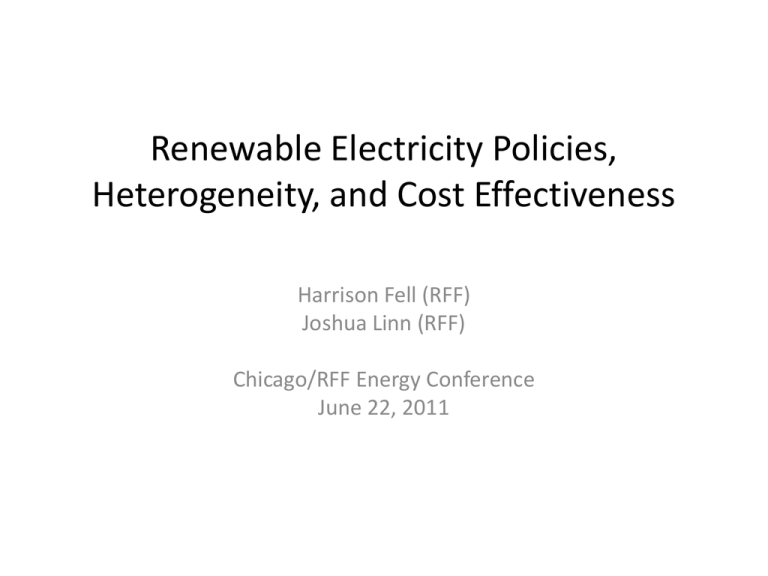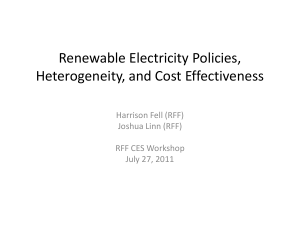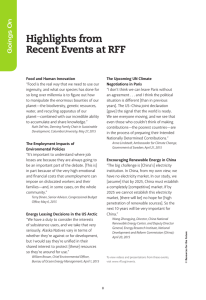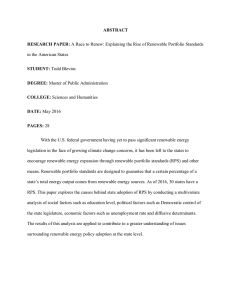Renewable Electricity Policies, Heterogeneity, and Cost Effectiveness Harrison Fell (RFF) Joshua Linn (RFF)
advertisement

Renewable Electricity Policies, Heterogeneity, and Cost Effectiveness Harrison Fell (RFF) Joshua Linn (RFF) Chicago/RFF Energy Conference June 22, 2011 Overview of the paper • Document spatial heterogeneity in market and environmental value of wind generators • Renewable electricity policies treat renewable generation as equally valuable • Analyze long run electricity market outcomes under different policies: what are implications of ignoring heterogeneity? 2 Background: renewable electricity policies • Around the world, several classes of renewable electricity policies – Feed-in tariff: price guarantee (Europe) – Renewable electricity standard: quantity mandate (U.S.) – Investment and production subsidies • Common theme: create incentives to invest in new renewable generation capacity 3 Background: heterogeneity • Recent literature on wind and solar – Intermittency: generate electricity when resource is available – Market value depends on correlation with demand/price (Lamont, 2008; Joskow, 2010, and Castillo and Linn, 2011) – Environmental value depends on displaced emissions from marginal generator; varies over time and space (Cullen, 2011; Kaffine et al., 2011) • What does heterogeneity mean for policy? – Typically, renewable electricity policies provide the same implicit subsidy regardless of market or environmental value – What is the cost of not fully internalizing these values? 4 Outline of paper and presentation • Focus on: – ERCOT (Texas) and PJM (Pennsylvania, New Jersey, Delaware and Maryland) – Wind (solar to come…) • Document heterogeneity – Use observed electricity prices to estimate market value – Complements literature on environmental value • Simple investment model – Different policies cause different wind investments – Characteristics of wind generators affects non-renewable investment, demonstrating importance of long run analysis • Simulations using more detailed model – Taking existing system as given, estimate investment needed to meet future demand growth – Compare baseline with carbon price and RPS (other policies to come5 …) Market and environmental value of wind generation • Wind data – Data from from NREL and ERCOT – Hypothetical units selected based on resource availability – Hourly simulated generation using atmospheric conditions, 2004-2006 • Market value – Using 2006 price data, estimate average price each simulated wind generator would have received – Estimate average cost of energy (LCOE) using 2010 cost assumptions and simulated capacity factor 6 Map of regions used for simulated wind generators (ERCOT) 7 Example of Hourly Capacity Factor of Two Simulated Units (ERCOT) June 28, 2006 120 0.9 0.8 0.7 80 0.6 0.5 60 0.4 40 0.3 Capacity Factor Price ($/MWh) 100 0.2 20 0.1 0 0 0 5 Price 10 15 Unit 236 (right axis) 20 25 Unit 401 (right axis) 8 Average Electricity Price vs. Levelized Cost of Energy 9 Conclusions on heterogeneity • Market value – Even among high-wind locations, average cost varies – Average revenue varies because of correlation with prices – Cost and revenue are negatively correlated • Environmental value varies across regions and generators – Cullen (2011) and Castillo and Linn (2011): 0.72 tons CO2/MWh (ERCOT) – Kaffine et al. (2011): 0.27 tons CO2/MWh (CAISO); 0.52 tons CO2/MWh (ERCOT); 1.10 tons CO2/MWh (MISO) • Upshot: it matters which generators will be constructed under renewable policies – This is different from new non-renewable generators, which much are more similar (within a technology) 10 • Model structure Summary of simple model – Two time periods, day/night (high/low demand) – Coal is base load, natural gas is peaking – Two types of wind: produces at night or during day • Renewable investment affects mix of non-renewable investment – Nighttime wind displaces coal, which reduces amount of coal used during day – Distinction between short run and long run • RPS creates different incentives from carbon price – RPS mandates fraction of renewable electricity, effectively subsidizing each MWh of renewable and taxing each MWh of non-renewable – Carbon price raises marginal cost in proportion to emission rate – Carbon price raises electricity price more at night – RPS effectively adds a flat subsidy to the market revenue, and favors wind that produces during the day 11 Long run planning model • Compare renewable policies and electricity price in the long run – Do types of renewable investments and mix of nonrenewable investments vary across policies? – Compare investment, emissions, welfare of producers and consumers, across policies • Investment stage – Separately model ERCOT (PJM still to come) – Starting in 2006, allow for investment in initial time period to meet demand growth over time – Model each existing generator separately – Investment in 7 technologies: coal (two types), natural gas (two types), wind (two types), nuclear; homogeneous within type 12 Model structure (cont.) • Electricity market clears each hour for next 25 years • Assume linear demand curve with price elasticity of -0.20 • Generators dispatched based on marginal cost, accounting for planned maintenance/outages • Account for heterogeneity across existing (2006) generators • Two types of wind generators: high and low correlation with 2006 prices 13 Solution Method • Maximize social welfare: T max ∑ β t −1 H ∑( K =t 1 = h 1 1 2 ( Pmax,ht − Pht )Qt + Pht Qht ) I exist I new H H t −1 − ∑ β ∑ FOM it Ki + ∑ ( cit qiht ) + ∑ FOM it Ki + ∑ ( cit qiht ) t 1= h 1 h 1 = = = i 1 i1 T I new − ∑ Fi Ki i =1 • Subject to production constraints • Because of non-linearities in short run supply curve, solve maximization via genetic algorithm 14 Scenarios • Baseline – Fuel price and capital cost assumptions from AEO 2010 – Observed heat rates for existing generators (EIA, EPA); operating and maintenance characteristics from Haiku – Project 1 percent annual demand growth • Production Tax Credit: $20/MWh • Carbon price: $30/ton • RPS: same amount of wind as carbon price 15 Overview of results • Investment – Mix of renewable generators varies by scenario – Mix of non-renewable generators also varies • Electricity prices, emissions, and producer/consumer welfare – Electricity prices increase with emissions price and decrease with RPS – Welfare costs to producers and consumers greater for RPS than emissions price, reflecting different investment mix 16 Table 1: Investments (MW) Technology Base PTC P-e RPS Coal 0 0 0 0 IGCC 0 0 0 0 Gas/Oil Comb Cycle 13,351 10,613 0 3,590 Gas Comb Turbine 0 0 0 0 Nuclear 0 0 0 261 Wind (low corr.) 0 2,770 8,768 3,585 Wind (high corr.) 0 2,529 9,200 12,689 17 Electricity prices by scenario Production-Weighted Average Annual Price 80 Base PTC Pe RPS 75 70 $/MWh 65 60 55 50 45 2005 2010 2015 2020 2025 2030 year 18 Welfare costs relative to baseline Scenario w/ Capital Cost w/o Capital Cost PTC 27.39 67.05 Pe 31.77 24.21 RPS 33.89 49.43 19 Conclusions and future work • Market and environmental value vary across wind generators • Renewable electricity policies tend not to account for this • Renewable policies and emissions price cause different mixes of renewable and non-renewable investment – Compared to emissions price, RPS causes more investment in high-correlation wind • Future work for this paper and beyond: – – – – Modeling enhancements, such as operating constraints Add solar, PJM Compare with clean energy standard and feed-in tariff Uncertainty and multiple investment stages 20







